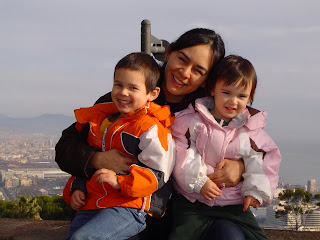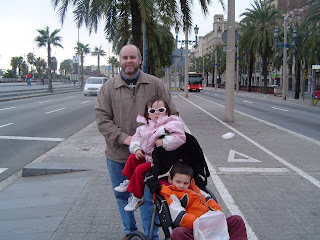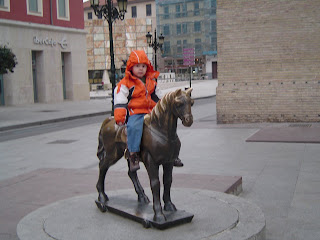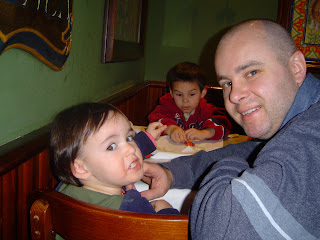So last week was all about preparing for this weekend. We decided to invite Jim's coworkers to celebrate Jim's 37th birthday. We had a great time at the party. There was a lesson learned: you can not buy ice at the gas station, or the supermarket; Jim got instructed by the Swiss to use his freezer at home. The kids went with the sitter to the mall to the Kinder paradise (indoor playground) and came back before all the guests were gone so they got to say hi and meet some of our friends. JP and Syd went to sleep before everybody left. This morning (Sunday 27th), JP got up and asked where all the friends were; He was very disappointed that the party was over.
This week was also very exciting for me because not only did I work at the multilingual school for a couple of days, but I also got called to sub twice. Jim and the kids have been very supportive of this new schedule of ours. The kids get up early, the transition at school is fairly easy and they welcome me in the afternoon with a big smile, hugs and kisses. Jim had to settle for simpler dinners and no special breakfasts. In the next weeks I will know if I will get a full time job for the next school year.
Sunday, January 27, 2008
Sunday, January 06, 2008
First weekend of 2008 at home
Este fin de semana, Jim decidio que debiamos festejar mi cumpleanos asi que me sorprendio con una visita a nuestra masajista y amiga Anna de 90 minutos. Una vez relajada, llevamos a los ninos al Kinder Paradise donde jugaron mientras Jim y yo distrutamos de una rica cena. Este fin de semana tambien nos dedicamos a limpiar, guardar el arbol de navidad (y demas adornos), y actualizar el blog para poder compartir con familia y amigos nuestra aventura en la madre patria Espana.
Saturday, January 05, 2008
Barcelona
Barcelona is one of the bigger (if not the biggest) cities in Spain. Even for a "laid back" country like Spain, Barcelona seems to have a big city feel - so many people, restaurants, Las Ramblas (Barcelona 5th Avenue), Theater District, etc. In looking at the map, the city was too big for us to cover on foot, so we explored the area around our hotel (which was connected to a huge shopping mall) and agreed to sign up for a bus tour the next day. That night we saw on the news that there was a transit workers strike taking place in the country. They caught on camera many disgruntled transit workers dumping trash, painting graffiti, and creating slippery surfaces in the metro stations, which explains the metro conditions we experienced in Madrid (forgot to mention that, but the subway stations in Madrid were absolutely littered with garbage). We got up the next morning and went to the tour bus stop down the street from our hotel, only to find that the tour buses were also affected by the strike and would not be in operation for the duration of our time in Barcelona. As traffic and parking are difficult, our only option was to explore the city on foot, making use of the subway where possible. We started in the northeast quadrant of the city where the architect Antoni Gaudi performed most of his work. Gaudi lived from the mid 1800's to early 1900's and the buildings he designed were way ahead of his time. The first building we saw was an apartment building called La Pedrera (which means abandoned stoned quarry, a name given by critics of the structure). Gaudi tended to use distorted geometries to give his buildings a very wavy, non-linear look. Imagine looking at the facade of an apartment building where every unit is noticeably different – window size, size of balcony, depth of unit with in the building…its difficult to explain in words, maybe the picture can do a better job. The next building we looked at was the Sacred Family church (La Sagrada Familia). This is an amazing structure which has three facades (depicting the birth, passion, and resurrection of Jesus) and 18 steeples honoring the 12 apostles, 4 evangelists, the Virgin Mary and Jesus Christ. At this time, only two of the facades are complete and 8 of the steeples. The project is funded by private donation from those that appreciate the work of Gaudi. It is scheduled for completion in 30 years. We next saw the House of Spikes (very Gothic looking building). We decided to take the metro down to the waterfront for lunch. When we got there, it started to rain and we forgot our umbrella, so quickly picked a spot and had a nice relaxing lunch. This time, we sampled the Barcelona paella (a seafood paella), which we definitely thought to be the best. After lunch, we took the metro back to the hotel. As it was still raining, we decided to hop in the car and sightsee with our last couple hours of daylight. We drove up to the Park Guell, which was a park designed by Gaudi. Again, we were absolutely amazed. It is not your typical park. Two pavilions (for use by the gatekeeper) stand at the entrance way into the park, which look like something out of the Hans and Gretel fairytale. A staircase leads up to a spectacular dragon fountain, and past that, a very deep cavernous area (Hypostyle Hall) which has numerous posts for support. The ceiling of this area is wavy and decorated with the fragments of broken glass and plates. Another stairway leads to the area above the cavern, which is just an open, dirt covered square, surrounded by a continuous wavy bench that, given the elevated height of this area, also serves as a guard rail. Like the ceiling in the cavern below, each small segment of the bench was decorated in a different design with the fragments of broken glass and plates. As this park is at the top of a hill, this particular area provided a beautiful viewing platform over the rest of the city. We figured we had seen enough for the day and headed back to the hotel for dinner and rest. The next day, we decided to explore the Montjuic Park area which is in the Southwest quadrant of the city. From one of the metro stops, we took a funicular to the base of the park. From there, we took a gondola up to the highest point of the park, where sits Montjuic castle. The castle was fairly unimpressive, probably due to the fact that it was not built to defend the city, but to overlook it. From that standpoint, it did offer some spectacular views. We continued our tour and saw the Olympic Stadium, National Museum, Magic Fountain, and Plaza Espanya. Having fully explored this part of the city, we decided to explore a bit of the South East quadrant, known as the Gothic Quarter. In this section of town lies the Cathedral (with an impressive outdoor courtyard), Barcelona Town Hall, and headquarters of the Generalitat autonomous government as well as the remains of some buildings built by the Romans. The next day was Saturday, the eve of Three Kings Day. This is a big day in Spain. They celebrate when the Three Kings brought gifts to Jesus and is also a big present day for the kids. We heard that later in the day, the Three Kings would arrive by boat to Barcelona and they would lead a parade through town. So we decided to be around the port area in the late afternoon, which is also home to a shopping mall and an aquarium (the second largest in Europe, the first being Genoa which we saw last year). We started the morning at the Palace of Music - a fantastically designed building. We were unable to visit the inside as all the tours were sold out for the day. Therefore, we proceeded directly to the port via a short walk along the Ramblas. This is a very wide street lined with shops and restaurants. A very generous median is home to numerous street performers and souvenir stands. The volume of people on this street leads me to believe that this is the heart of the city. We eventually made our way to the port and proceeded directly to the shopping mall. The mall did not have much to offer, so we had lunch and made our way to the aquarium. The kids once again had a blast exploring all the underwater creatures. As we were finishing up our tour, we heard fireworks and concluded that the Three Kings must be arriving. We quickly got outside and made our way to the area where probably 10s of thousands of people were congregating. We saw a small parade of people in costume but could not see what was happening from our vantage point. We got closer and eventually got close enough to see the Three Kings on a stage receiving the key to the city from the mayor. One of the kings (Balthazar I believe) made a speech and then they continued their procession along the parade route. The kids (all the kids, not just ours) were cheering, shouting, and just going nuts at the sight of the Kings!!! Sandy and I are currently debating whether the Three Kings or Santa Clause has higher stature in Spain. After that, we fought the crowds back to the hotel. We discovered a mini outdoor funpark a couple of nights prior and decided that with the volume of people checking out the Three Kings, we might have the funpark to ourselves. We were wrong, however, the kids did not have to wait long to get into the bouncy bounch, funhouse, or on the merry go round. The next day was our travel day back to Switzerland. The flight was not until the afternoon, so we took advantage of the morning to pack our bags and headed back to the funpark one last time.

This seafood paella looked and tasted yummy!

Gaudi's work
Friday, January 04, 2008
Valencia
The next stop was Valencia. We left Zaragoza in the late morning and the kids snoozed for probably two of the three hour trip to Valencia. There was some really amazing scenery on the way to Valencia, as well as on the way to Zaragoza. The center of the country (outside of Madrid) is flat with views of plateaus and mountain ranges in the distance. The soil is dark red in many places, but you also see shades of white, purple, and speckles of green where there is some vegetation - an incredible site when the sun hits it in the right places. We arrived in the early afternoon and signed up right away for a bus tour. Valencia is essentially divided into two parts - the "old town" and the City of Arts and Sciences. A river once flowed through Valencia. After experiencing some flooding, the waters were diverted and numerous parks were built in the area once occupied by the river. In one of these areas, Valencia built the City of Arts and Sciences - a huge complex consisting of four different buildings - aquarium, planetarium, performance center, and science museum. The buildings are all of modern architecture, similar in style to the famous Opera Hall in Sydney Australia. Each building is really incredible to look at individually, but the view is absolutely spectacular when you have all four in view at the same time. We spent the first day exploring the old town. After dinner, we found that we were stranded in this part of the city due to a New Years Eve race through town. All the streets were blocked off to traffic, so we had to walk back to the hotel, which turned out to be closer than we thought and gave us an opportunity to see some of the sites up close. The next day, we scouted out the City of Arts and Science in the morning and then went back downtown in the afternoon, and took a closer look at some of the sights like The Tower of Los Sarranos and The Towers of Quart (original gateways into the city), the central market (huge indoor market where you can sit on the lap of the Three Kings (see Barcelona)), The Palace of the Marquis of Dos Aguas (really impressive marble and plaster work on this building – see the picture), and the Tower of Miguelete (tower connected to the Valencia Cathedral). We ended the day at the beach building sand castles and discovered a series of paella restaurants along the boardwalk. It was too late to have paella (usually served 1-5pm), so we decided to come back the next day for paella Valencia. The next day was New Years Day, and after brunch, we spent the day at the aquarium and the science museum - the kids had a blast looking at all the exotic underwater creatures like sea dragons (like a sea horse only more elaborate), eels, manta rays, etc. Did you know that there is actually a fish that spends most of its life outside water? It is called an Atlantic Mudskipper - interesting huh? Between museums we went back down to the beach and had our paella, which was fantastic. The key ingredients in Paella Valencia are chicken and rabbit. The following day we found ourselves back at the beach building sandcastles one last time before making our way to our final destination, Barcelona. Once again, the kids slept most of the way. Sandy and I used the opportunity to start documenting our trip to update the blog in a timely manner when we got back to Zurich - little did we know there would be so more things to see (and record for the blog) in Barcelona.
Even JP liked the commentary on the tour bus

Performing Arts Center at the City of Art and Science
Thursday, January 03, 2008
Zaragoza
After convincing the kids that there was a better place for children in the next city, we were able to get back on the road to Zaragoza. We got there in the afternoon and stayed for 2 days. We stopped into the tourist office when we got into town and they gave us directions to an indoor playgroup in a mall. It was late in the day so we decided to spend the rest of the afternoon there and start early the next day with our sightseeing. We started our sightseeing with the Palace of Aljaferia. This is a very interesting palace because the architecture is of three different styles, corresponding to construction performed during three different periods of time: During the 11th century, the palace was built by the King Abu Jafar Moctadir. It was refurbished in the 12th century in Mudejar style after the reconquest of the city by the Christians. An extension to the palace was ordered by the Catholic Kings between 1491 and 1492. Next we visited what is probably the banner monument in Zaragoza, the Basilica of the Pilar, which is one of the most important sanctuaries in the Catholic world devoted to Virgin Mary. Popular belief is that Virgin Mary still living in Jerusalem came to Zaragoza to comfort the Apostle Santiago. She brought the column (pilar) to build the first chapel and the present day basilica was built up around it. What catches the eye from the outside are the 13 steeples and multicolored tiles of the roof, not to mention just the huge scale of this church (takes up a city block). On the inside are beautiful works of art by Goya among other artists. Scale is noticed again on the inside, especially when looking at the pillars, which are the size of a small house. Parishioners singing villancicos (christmas carols, focused on jesus) gave it a very warm feeling. This cathedral also displayed a life size belem that you actually walk through. More sites of Zaragoza include Puerta del Carmen (the only original gateway to the city still standing in the form of a Roman triumphal arch), the stone bridge (15th century stone bridge flanked by four bronze lions), and the Cathedral of San Salvador. After a long day of sight seeing, we treated the kids to another stop at the indoor playground, which we all enjoyed thoroughly and ensured a good night sleep.

Palace of Aljaferia

Plaza del Pilar
Wednesday, January 02, 2008
Guadalajara
Our next destination was Zaragoza, however we stopped in Guadalajara (about 30 minutes outside Madrid) for the day. We did a walking tour of the city visiting Alcazar Real (an Arabic castle from the 11th century), Iglesia de los Remedios, and Palacio del Infantado (Palace of the dukes of the Infantado, now home to a free history museum that was worth the stop). Guadalajara is a small city easy to get around on foot, and is home to some very interesting architecture left over from when the country was under Arabic rule between the 8th and 13th centuries. The city happened to be having a children’s fair on the day of our visit, so we gave JP and Syd some time to play in the bouncy bounce and ride the train – a move that paid off since they slept the remaining two hours to Zaragoza.


Tuesday, January 01, 2008
Madrid
We had our Christmas/New Years holiday this year in Spain. The first stop on this two week trip was Madrid. We traveled on Christmas Eve and spent our first full day in Madrid on Christmas Day. Since we knew we were going to travel during this time, we celebrated Christmas early and frequently: we followed the Swiss tradition and celebrated Santa Clause Day on Dec 6 and the birth of baby Jesus the weekend before Christmas (you will see at the end that we also celebrated the eve of Three Kings Day on Jan 5). After attending mass at the church across the street from the Puerta de Alcala y Parque del Retiro, we decided to take advantage of the deserted city and visited Palacio Real, Plaza Espana, Plaza Mayor, and the spectacular Plaza de Toros. We were somewhat disappointed with the Plaza Mayor as it hosted a market where the only things sold were silly wigs and other “gag gifts” – not fitting for such a historic plaza - however Madrid had much more to offer. The following day was all about the art. The museum triangle formed by the Museo del Prado (featured El Greco, Goya, Rembrandt), Museo National Centro de Arte Reina Sofia (Picasso, Joan Miro, and Salvador Dali) and Meseo Thyssen Bornemisza (Monet, Degas, Piccaso) was a real treat, we started early in the morning and the line to buy tickets was already around the block. However, we discovered that children don't have to wait in line. As we were lucky to have two with us, we bypassed the line and were in the museum in a matter of minutes (kids - never leave home with out them!). On our last day in Madrid, we visited more sites of the city. The Spanish people really take pride in the nativity displays called "belen" by the locals. Every church we visited had its own and we saw some with real intricate designs including waterfalls, vast landscapes, buildings, etc. Madrid offered also more than the typical tapas (appetizers) in terms of food. We had some delicious lunch menus (a menu is a fixed 3 course meal) that included typical dishes such as paella, albondigas (meatballs), seafood and meats. These menus include starter, main dish, desert, coffee and a whole bottle of a local young wine (most of the Spanish reds are made from tempranillo grapes). The best part of this deal was that its all for 9 euros (about $13). In terms of the weather, we had clear skies in the mornings but a little cold (close to the 30s). It would usually warm up in the afternoon going up to the 50s.

Puerta de Alcala

Palacio Real
Subscribe to:
Posts (Atom)









































